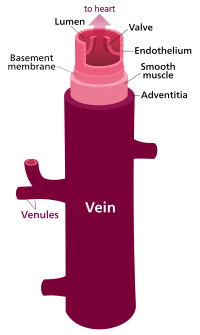
Photo from wikipedia
Objective Effective therapies for reflux hypersensitivity are lacking. Endoscopic radiofrequency ablation may reduce the sensitivity of the distal esophagus through direct interference with nociceptors or vagal afferent fibers and thus… Click to show full abstract
Objective Effective therapies for reflux hypersensitivity are lacking. Endoscopic radiofrequency ablation may reduce the sensitivity of the distal esophagus through direct interference with nociceptors or vagal afferent fibers and thus may be useful in reflux hypersensitivity. The aim of this study is to assess the effectiveness and possible mechanisms of endoscopic radiofrequency ablation in reflux hypersensitivity patients. Methods Patients with reflux hypersensitivity who fulfilled the Rome IV criteria and who wished to receive further treatment were recruited. Endoscopic radiofrequency ablation was delivered to the gastroesophageal junction. Data were collected by questionnaire using a 6-point Likert scale. The primary outcome measure was effect on symptoms including heartburn, regurgitation, and chest pain. The secondary outcomes were degree of satisfaction, medication use, acid exposure time (AET), low esophageal sphincter (LES) pressure, and total reflux episodes. We also assessed positive cell density of transient receptor potential vanilloid type 1 receptor (TRPV1) and calcitonin gene-related peptide (CGRP), both of which are biomarkers of afferent fibers, in biopsies obtained from esophageal mucosa 0.5 cm-1 cm above the Z line. These scales will be administered at baseline, 3-month follow-up, 6-month follow-up, and 12-month follow-up. Results A total of 22 reflux hypersensitivity patients were enrolled (14 males, median age 50.0 years). A significant improvement in symptom scores (heartburn, regurgitation, and chest pain) was noted at 3 months, 6 months, and 12 months (P < 0.001). Satisfaction with life increased to 72.7% (16/22), 72.7% (16/22), and 68.2% (15/22) at 3, 6, and 12 mo, respectively, compared with baseline (P < 0.001). Nineteen patients reduced their medication use after treatment. Of these, 22.7% (5/22), 31.8% (7/22), and 40.9% (9/22) subjects stopped medication use at 3 mo, 6 mo, and 12 mo, respectively. No statistical differences were noted in AET, LES pressure, or total reflux episodes from preoperation to 12 mo postoperation. After treatment, the positive cell density of both TRPV1 and CGRP decreased significantly; however, only TRPV1 had a positive correlation with heartburn (r = 0.51, P = 0.03) and chest pain (r = 0.77, P < 0.01). Conclusion Endoscopic radiofrequency ablation was an effective and safe therapeutic option in reflux hypersensitivity patients. Further studies with large sample size are required to validate the role of radiofrequency in reflux hypersensitivity.
Journal Title: Gastroenterology Research and Practice
Year Published: 2022
Link to full text (if available)
Share on Social Media: Sign Up to like & get
recommendations!